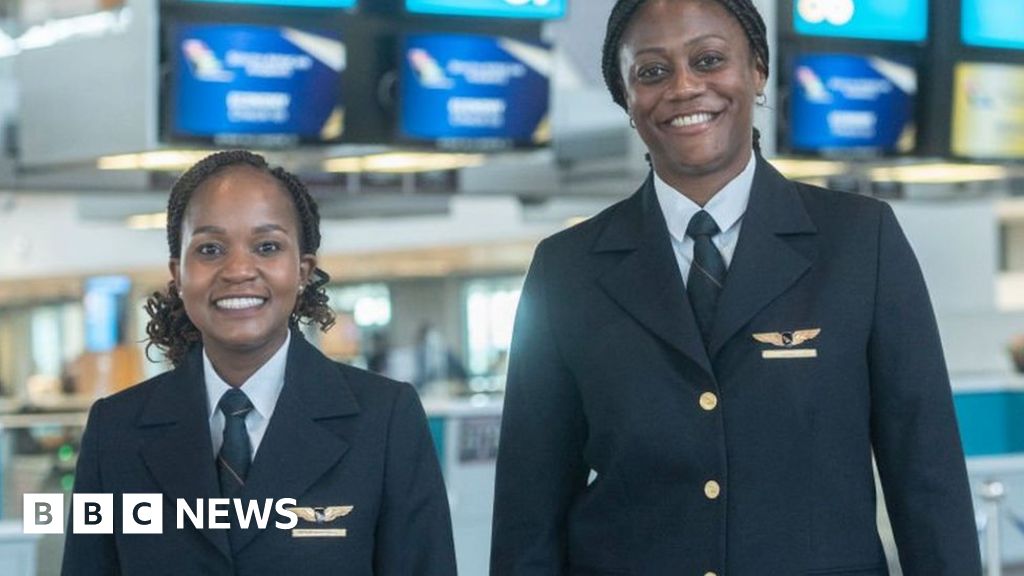- By Jewel Kiriungi
- BBC News, Johannesburg
Image source, Getty Images
South African Airways – once a giant of African aviation – is back in the intercontinental market, but there are still doubts about its financial viability.
It had disappeared from our skies altogether in September 2020, having fallen victim not just to Covid but also another disease that has plagued some other state-run carriers – corruption and mismanagement.
It may be on the verge of a sale that would see a private consortium take a majority share in the business.
However, its handling of finances has recently come in for severe criticism by the country’s public spending watchdog.
In a scathing report, Auditor-General Tsakani Maluleke said that the financial statements SAA had drawn up dating from the 2018-19 financial year lacked credibility. The airline recorded losses in the four years from 2018 of a staggering $1.2bn (£1bn).
But interim chief executive officer (CEO) John Lamola said this did not reflect the current position of the airline, which is under new management.
He said the situation had improved in the most recent financial year, with the airline now “running on financial resources generated from its own operations”.
Towards the end of last year, in a sign that SAA wants to be a major player again, it reopened its routes from Cape Town and Johannesburg to São Paulo, Brazil. And now it is selling tickets for flights to Perth, Australia.
These are the airline’s first long-haul destinations in three years. It did return in September 2021, making a surprise profit serving a limited number of African destinations after coming out of voluntary business rescue.
This was a process which saw the airline placed under the temporary supervision of experts who were asked to return the company to financial health. They pared back the fleet from 44 aircraft to six and focused on the African market.
Image source, Getty Images
Now it is aiming further afield.
“The choice of São Paulo was as a result of a very meticulous economic and market research analysis,” Mr Lamola told the BBC.
He added that the intercontinental flights hoped to enhance trade and tourism ties between the two countries as members of Brics – an expanding group of emerging economies originally comprising Brazil, Russia, India, China and South Africa.
Prior to the Covid pandemic, SAA operated five other intercontinental routes from Johannesburg to destinations including New York and Hong Kong.
That route encapsulates the prestige that used to accompany the airline. Once the largest in Africa, SAA faced profound challenges in the last decade.
“South African Airways notoriously has gone through a process in South Africa called ‘state capture ‘, where there are well-recorded incidents of corruption that characterised the life of the airline,” said Mr Lamola, adding that investigations were ongoing.
An official inquiry into state capture released at the beginning of 2022 showed that the airline had been wracked by corruption between 2012 and 2017.
As a result of the mismanagement, SAA was forced to rely entirely on government financial assistance over a 10-year period to stay afloat, a situation made worse by Covid.
“In that period… the government had to put in some 40bn rand ($2.2bn) into SAA,” said Public Enterprises Minister Pravin Gordhan.
It had been run at a loss since 2011.
The national carrier was placed under voluntary business rescue in 2019 to protect it from bankruptcy.
It was then forced to suspend all operations in September 2020, as it struggled to raise a bailout of over $540m.
As part of a programme to rescue the airline, the government announced plans, in June 2021, to sell a 51% stake in SAA to a group known as the Takatso Consortium.
Under the scheme, the government’s department of public enterprises retains the remaining 49% stake, securing a long-term national strategic interest in the airline.
Last July, it was approved by the Competition Tribunal of South Africa provided that certain conditions were met.
One of the requirements was a moratorium on staff cuts that guarantees job security for SAA employees during the transitional phase.
But it has hit problems, with trade unions alleging that proper procedures were not followed. A parliamentary committee plans to subpoena Mr Gordhan to investigate this further.
Takatso, with its huge cash injection, had been seen as a lifeline for SAA, but the airline says it will carry on with its expansion plans in the meantime.
SAA’s new management hopes to shift the business from its dependence on state support to a financially self-sustaining one, by only maintaining a fleet it can afford and pulling out of the low-cost market.
“This airline must be able to survive on operational efficiencies,” said Mr Lamola.
These include choosing routes for commercial rather than political reasons, building a fleet with appropriate long-haul aircraft and matching expansion with the pace of the post-Covid recovery in the global aviation industry.
Image source, Getty Images
Aviation analyst and founder of online publication Airspace Africa, Derek Nseko, told the BBC that “this is a much more sensible South African Airways and there is a lot of confidence to be gained from some of the measures that they have taken since the business rescue process ended”.
Despite the fanfare around the return of SAA to intercontinental travel, the airline is still looking to build up its business within Africa, taking on 15 extra regional routes, along with four domestic ones by March 2025.
“We are focused on generating many alliances. We have code shares with, for instance, Kenya Airways and other airlines on the continent, where we are working together to stimulate air travel in Africa,” Mr Lamola said.
Referring to the clearance of historical debts, Mr Gordhan said that “all the muck has been cleared out, and the state has taken responsibility for that… to get operations that we see currently getting off the ground”.
Many will be keen to see whether SAA will “rise from the ashes of state capture like a phoenix”.
“African airlines are still being projected to make a loss this year,” with airlines such as Air Zimbabwe also undergoing restructuring, analyst Mr Nseko told the BBC.
Nevertheless, Ethiopian Airlines and EgyptAir have both said they have had a profitable year.
Ethiopian Airlines, which is state-owned, offers a successful model that SAA could follow.
It has diversified its operations, including cargo, maintenance, repair and training services to create multiple revenue streams.
It has also focused on connecting regional destinations and capitalising on demand for intra-African travel.
This strategy has helped the airline become one of the largest and most profitable in Africa.
Turbulence ahead
But high operating costs made worse by rising inflation and currency devaluation threaten the ability of African carriers such as SAA to run profitably, as financiers and those prepared to lease aircraft see the African market as a risk.
Additionally, inconsistent and complex regulatory frameworks in different African countries have been barriers of entry for airlines and investors on the continent.
The African Union’s Single African Air Transport Market has tried to create a unified air transport market on the continent, but it remains a work in progress.
However, SAA boss Mr Lamola argues that businesses must also step up and create solutions.
“I think we have made a mistake of expecting the political authorities in our various countries to solve these problems. But really, they are business problems,” he said.
“We need more aviation entrepreneurship in Africa, where innovative means have to be found. We need more concrete interventions of entrepreneurs who will be able to go out there and innovate on issues around financing.”
While SAA’s new business strategy offers a promising future, the skies ahead will not be free of turbulence.
“The African aviation landscape is extremely difficult and the jury is still out on what the future looks like for South African Airways,” said Mr Nseko.










